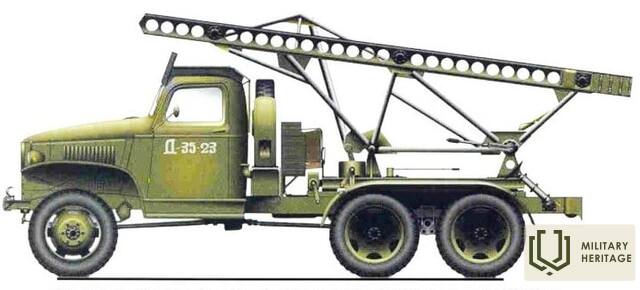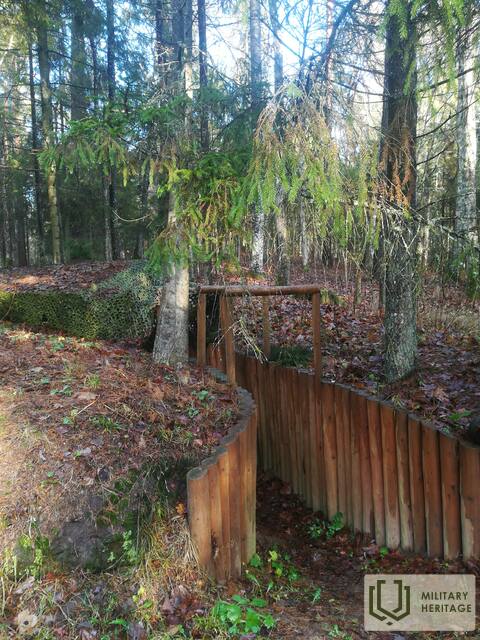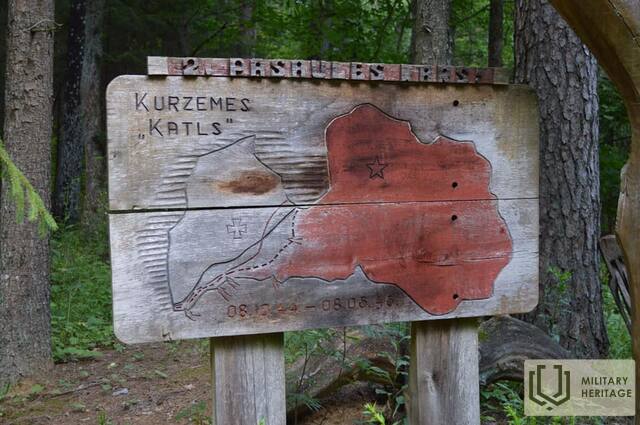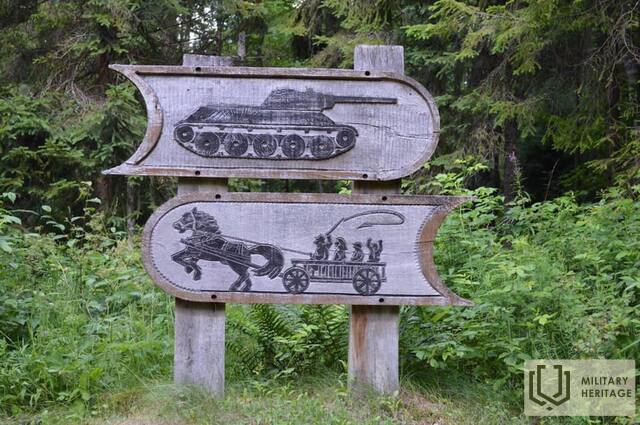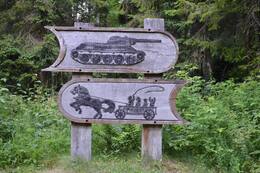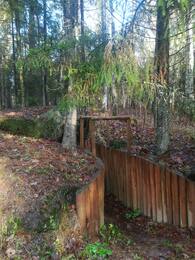Aizvīki Kuržemės katile
Aizvykių parke vis dar galima aiškiai pamatyti Antrojo pasaulinio karo bunkerių, apkasų ir kaponierų pylimų liekanas, kuriose buvo laikomi ginklai. Viena iš ginklų rūšių buvo raketų paleidimo sistema „Katiuša“.
Kuržemės katilo metu nuo 1944 m. spalio 8 d. iki 1945 m. gegužės 8 d. Aizvykių apylinkės buvo antroji sovietų armijos fronto linija, arba tiekimo linija, tačiau parke buvo įrengti apkasai ir bunkeriai, taip pat vieta įvairiems ginklams laikyti. Vienas iš šių ginklų buvo raketų paleidimo sistema „Katiuša“, pagaminta amerikietiško sunkvežimio „Studebaker US-6“ pagrindu. Trumpai apie šios kovinės mašinos istoriją -
1941 m. birželio 17 d. Maskvos poligone įvyko naujos Raudonosios armijos karinės technikos pristatymas, paskutinėje vietoje buvo pademonstruota naujausia raketų paleidimo sistema. Demonstracija padarė labai gerą įspūdį vadovybei. Įsakymas pradėti serijinę šių kovinių mašinų gamybą buvo pasirašytas vos po 3 dienų, kai iki karo pradžios buvo likusios vos kelios valandos. Birželio 26 d. Voronežo gamykloje buvo baigtos gaminti pirmosios dvi serijinės transporto priemonės, gavusios žymėjimą BM-13. Jos buvo skirtos paleisti 132 mm raketų sviedinius. Šis paleidimo įrenginys buvo sumontuotas ZIS-6 sunkvežimio pagrindu. Po salvės paleidimo raketų sistema greitai pakeitė savo vietą, kad nepatektų į kontrataką. Vadai turėjo būti griežtai atsakingi už kiekvienos transporto priemonės praradimą.
1943 m. balandžio mėn. pradėta gaminti suvienodinta raketų paleidimo sistema BM-13N, kurios tikslas buvo pagerinti mašinos technines charakteristikas ir atpiginti gamybą. BM-13 N daugiausia buvo sukurtas amerikietiško sunkvežimio „Studebaker US-6“, kuris į SSRS buvo importuotas pagal nuomos sutartį, pagrindu. BM-13N galėjo paleisti sviedinį iki 8,5 km atstumu ir gabenti 16 sviedinių su 5–7 žmonių įgula.
Kelios tokios raketų paleidimo sistemos Aizvykių parke buvo įsikūrusios net ir pasibaigus Antrajam pasauliniam karui, ir šios vietos yra aiškiai matomos gamtoje.
Susijusi laiko juosta
Susijusios vietos
Antrojo pasaulinio karo liudijimai Aizvykių parke
Aizvykių dvaro parkas yra Aizvyčiuose, Gramzdos valsčiuje, vos už kelių kilometrų nuo Lietuvos sienos.
Aizvykių parke vis dar aiškiai matomos Antrojo pasaulinio karo bunkerių ir apkasų vietos. Vienas iš ginklų tipų buvo raketų paleidimo sistema „Katyusha“. Kelios tokios raketų paleidimo sistemos Aizvykių parke buvo ir pasibaigus Antrajam pasauliniam karui, ir šios vietos (kaponieriai) yra aiškiai matomos gamtoje.
Šis unikalus miško parkas, apipintas paslaptimis ir legendomis, buvo įkurtas XIX a. pabaigoje kaip Aizvykių dvaro parkas, kai dvaro baronas fon Korfas netoliese esančią kalvotą žemę apsodino pušų ir eglių mišku. Vėliau 40 hektarų plote buvo įrengti pėsčiųjų takai, pasodinta ir kitų rūšių medžių, įkurtas fazanų sodas.
Be vaizdingų miško peizažų, parke taip pat yra medinių pasakų ir legendų personažų, taip pat akmens skulptūrų, kurios keliautojams pasakoja apie Aizvykių istorijos įvykius ir žymi kultūrines bei istorines vietas. Parke taip pat yra Žalioji klasė.
Norint geriau pažinti Aizvykių dvaro parko kultūrinį ir istorinį paveldą, rekomenduojame pasinaudoti gido paslaugomis.
Raudonosios armijos bunkeris ir kaponieriai Aizvykių parke
Aizvykių dvaro parkas yra Aizvyčiuose, Gramzdos valsčiuje, vos už kelių kilometrų nuo Lietuvos sienos.
Aizvykių parke vis dar aiškiai matomos Antrojo pasaulinio karo bunkerių ir apkasų vietos. Parke restauruotas Raudonosios armijos bunkeris.
Vienas iš Antrojo pasaulinio karo ginklų tipų buvo raketų paleidimo sistema „Katiuša“. Kelios tokios raketų paleidimo sistemos buvo įsikūrusios Aizvykių parke, ir net šiandien šios vietos (kaponieriai) yra aiškiai matomos gamtoje.
Norint geriau pažinti Aizvykių dvaro parko kultūrinį ir istorinį paveldą, rekomenduojame pasinaudoti gido paslaugomis.




